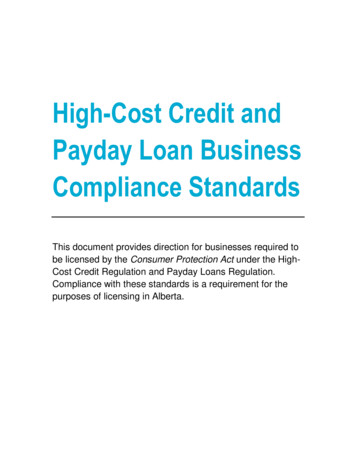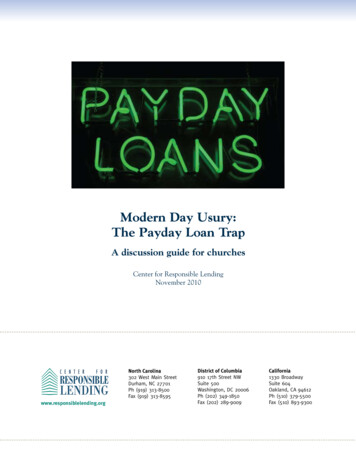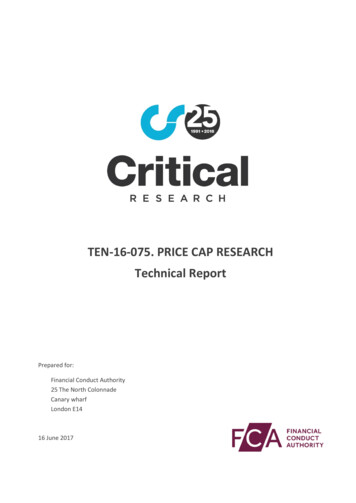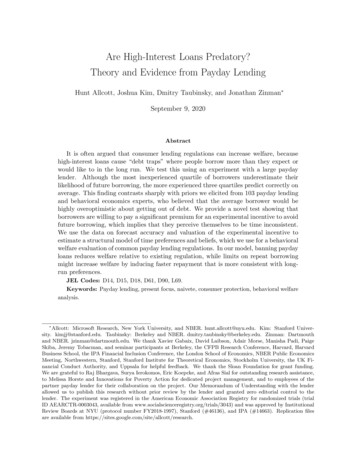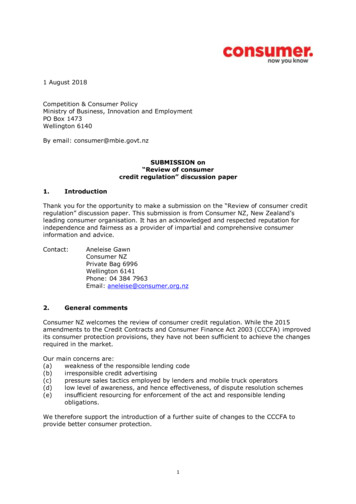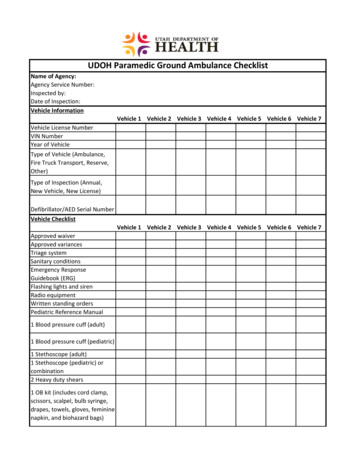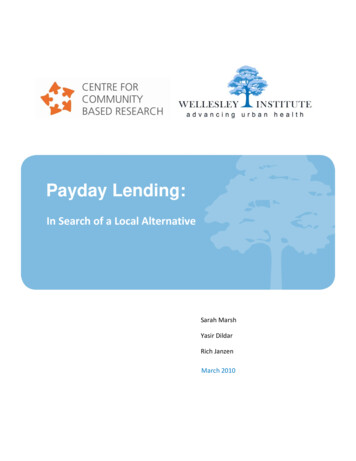
Transcription
BILLING CODE: 4810-AM-PBUREAU OF CONSUMER FINANCIAL PROTECTION12 CFR Part 1041[Docket No. CFPB-2016-0025]RIN 3170–AA40Payday, Vehicle Title, and Certain High-Cost Installment LoansAGENCY: Bureau of Consumer Financial Protection.ACTION: Final Rule; official interpretations.SUMMARY: The Bureau of Consumer Financial Protection (Bureau or CFPB) is issuing thisfinal rule to establish 12 CFR 1041, which creates consumer protections for certain consumercredit products, and the official interpretations to the rule. First, the rule identifies it as an unfairand abusive practice for a lender to make covered short-term or longer-term balloon-paymentloans, including payday and vehicle title loans, without reasonably determining that consumershave the ability to repay the loans according to their terms. The rule exempts certain loans fromthe underwriting criteria prescribed in the rule if they have specific consumer protections.Second, for the same set of loans along with certain other high-cost longer-term loans, the ruleidentifies it as an unfair and abusive practice to make attempts to withdraw payment fromconsumers’ accounts after two consecutive payment attempts have failed, unless the consumerprovides a new and specific authorization to do so. Finally, the rule prescribes notices toconsumers before attempting to withdraw payments from their account, as well as processes andcriteria for registration of information systems, for requirements to furnish and obtaininformation from them, and for compliance programs and record retention. The rule prohibits1
evasions and operates as a floor leaving State and local jurisdictions to adopt further regulatorymeasures (whether a usury limit or other protections) as appropriate to protect consumers.DATES: Effective Date: This regulation is effective [INSERT DATE 21 MONTHS AFTERDATE OF PUBLICATION IN THE FEDERAL REGISTER], except for § 1041.11, which iseffective [INSERT DATE 60 DAYS AFTER DATE OF PUBLICATION IN THE FEDERALREGISTER].FOR FURTHER INFORMATION CONTACT: Sarita Frattaroli, Counsel; Mark Morelli,Michael G. Silver, Steve Wrone, Senior Counsels; Office of Regulations; Consumer FinancialProtection Bureau, at 202-435-7700 or cfpb reginquiries@cfpb.gov.SUPPLEMENTARY INFORMATION:I. Summary of the Final RuleOn June 2, 2016, the Bureau issued proposed consumer protections for payday loans,vehicle title loans, and certain high-cost installment loans. The proposal was published in theFederal Register on July 22, 2016.1 Following a public comment period and review ofcomments received, the Bureau is now issuing this final rule with consumer protectionsgoverning the underwriting of covered short-term and longer-term balloon-payment loans,including payday and vehicle title loans. The rule also contains disclosure and paymentwithdrawal attempt requirements for covered short-term loans, covered longer-term balloonpayment loans, and certain high-cost covered longer-term loans.Covered short-term loans are typically used by consumers who are living paycheck topaycheck, have little to no access to other credit products, and seek funds to meet recurring or1Payday, Vehicle Title, and Certain High-Cost Installment Loans, 81 FR 47864 (July 22, 2016).2
one-time expenses. The Bureau has conducted extensive research on these products, in additionto several years of outreach and review of the available literature. The Bureau issues theseregulations primarily pursuant to its authority under section 1031 of the Dodd-Frank Wall StreetReform and Consumer Protection Act (Dodd-Frank Act) to identify and prevent unfair,deceptive, or abusive acts or practices.2 The Bureau is also using authorities under section 1022of the Dodd-Frank Act to prescribe rules and make exemptions from such rules as is necessary orappropriate to carry out the purposes and objectives of the Federal consumer financial laws,3section 1024 of the Dodd-Frank Act to facilitate supervision of certain non-bank financialservice providers,4 and section 1032 of the Dodd-Frank Act to require disclosures to convey thecosts, benefits, and risks of particular consumer financial products or services.5The Bureau is not, at this time, finalizing the ability-to-repay determination requirementsproposed for certain high-cost installment loans, but it is finalizing those requirements as tocovered short-term and longer-term balloon-payment loans. The Bureau is also finalizing certaindisclosure, notice, and payment withdrawal attempt requirements as applied to covered shortterm loans, longer-term balloon-payment loans, and high-cost longer-term loans at this time.The Bureau is concerned that lenders that make covered short-term loans have developedbusiness models that deviate substantially from the practices in other credit markets by failing toassess consumers’ ability to repay their loans according to their terms and by engaging inharmful practices in the course of seeking to withdraw payments from consumers’ accounts. The2Public Law 111–203, section 1031(b), 124 Stat. 1376 (2010) (hereinafter Dodd-Frank Act).Dodd-Frank Act section 1022(b).4Dodd-Frank Act section 1024(b)(7).5Dodd-Frank Act section 1032(a).33
Bureau has concluded that there is consumer harm in connection with these practices becausemany consumers struggle to repay unaffordable loans and in doing so suffer a variety of adverseconsequences. In particular, many consumers who take out these loans appear to lack the abilityto repay them and face one of three options when an unaffordable loan payment is due: take outadditional covered loans (“re-borrow”), default on the covered loan, or make the payment on thecovered loan and fail to meet basic living expenses or other major financial obligations. As aresult of these dynamics, a substantial population of consumers ends up in extended loansequences of unaffordable loans. Longer-term balloon-payment loans, which are less common inthe marketplace today, raise similar risks.In addition, many lenders may seek to obtain repayment of covered loans directly fromconsumers’ accounts. The Bureau is concerned that consumers may be subject to multiple feesand other harms when lenders make repeated unsuccessful attempts to withdraw funds from theiraccounts. In these circumstances, further attempts to withdraw funds from consumers’ accountsare very unlikely to succeed, yet they clearly result in further harms to consumers.A. Scope of the RuleThe rule applies to two types of covered loans. First, it applies to short-term loans thathave terms of 45 days or less, including typical 14-day and 30-day payday loans, as well asshort-term vehicle title loans that are usually made for 30-day terms, and longer-term balloonpayment loans. The underwriting portion of the rule applies to these loans. Second, certain partsof the rule apply to longer-term loans with terms of more than 45 days that have (1) a cost ofcredit that exceeds 36 percent per annum; and (2) a form of “leveraged payment mechanism”that gives the lender a right to withdraw payments from the consumer’s account. The payments4
part of the rule applies to both categories of loans. The Bureau had proposed parallelunderwriting requirements for high-cost covered longer-term loans. However, at this time, theBureau is not finalizing the ability-to-repay portions of the rule as to covered longer-term loansother than those with balloon payments.The rule excludes or exempts several types of consumer credit, including: (1) loansextended solely to finance the purchase of a car or other consumer good in which the goodsecures the loan; (2) home mortgages and other loans secured by real property or a dwelling ifrecorded or perfected; (3) credit cards; (4) student loans; (5) non-recourse pawn loans; (6)overdraft services and lines of credit; (7) wage advance programs; (8) no-cost advances; (9)alternative loans (similar to loans made under the Payday Alternative Loan programadministered by the National Credit Union Administration); and (10) accommodation loans.B. Ability-to-Repay Requirements and Alternative Requirements for Covered Short-Term LoansThe rule identifies it as an unfair and abusive practice for a lender to make covered shortterm or longer-term balloon-payment loans without reasonably determining that the consumerswill have the ability to repay the loans according to their terms. The rule prescribes requirementsto prevent this practice and thus the specific harms to consumers that the Bureau has identified asflowing from the practice, including extended loan sequences for a substantial population ofconsumers.The first set of requirements addresses the underwriting of these loans. A lender, beforemaking a covered short-term or longer-term balloon-payment loan, must make a reasonabledetermination that the consumer would be able to make the payments on the loan and be able to5
meet the consumer’s basic living expenses and other major financial obligations without needingto re-borrow over the ensuing 30 days. Specifically, a lender is required to: Verify the consumer’s net monthly income using a reliable record of incomepayment, unless a reliable record is not reasonably available; Verify the consumer’s monthly debt obligations using a national consumer reportand a consumer report from a “registered information system” as describedbelow; Verify the consumer’s monthly housing costs using a national consumer report ifpossible, or otherwise rely on the consumer’s written statement of monthlyhousing expenses; Forecast a reasonable amount for basic living expenses, other than debtobligations and housing costs; and Determine the consumer’s ability to repay the loan based on the lender’sprojections of the consumer’s residual income or debt-to-income ratio.Furthermore, a lender is prohibited from making a covered short-term loan to a consumerwho has already taken out three covered short-term or longer-term balloon-payment loans within30 days of each other, for 30 days after the third loan is no longer outstanding.Second, and in the alternative, a lender is allowed to make a covered short-term loanwithout meeting all the specific underwriting criteria set out above, as long as the loan satisfiescertain prescribed terms, the lender confirms that the consumer meets specified borrowinghistory conditions, and the lender provides required disclosures to the consumer. Among otherconditions, under this alternative approach, a lender is allowed to make up to three covered6
short-term loans in short succession, provided that the first loan has a principal amount no largerthan 500, the second loan has a principal amount at least one-third smaller than the principalamount on the first loan, and the third loan has a principal amount at least two-thirds smaller thanthe principal amount on the first loan. In addition, a lender is not allowed to make a coveredshort-term loan under the alternative requirements if it would result in the consumer having morethan six covered short-term loans during a consecutive 12-month period or being in debt formore than 90 days on covered short-term loans during a consecutive 12-month period. A lenderis not permitted to take vehicle security in connection with loans that are made according to thisalternative approach.C. Payment Practices RulesThe rule identifies it as an unfair and abusive practice for a lender to make attempts towithdraw payment from consumers’ accounts in connection with a short-term, longer-termballoon-payment, or high-cost longer-term loan after the lender’s second consecutive attempts towithdraw payments from the accounts from which the prior attempts were made have failed dueto a lack of sufficient funds, unless the lender obtains the consumers’ new and specificauthorization to make further withdrawals from the accounts. The Bureau found that in thesecircumstances, further attempted withdrawals are highly unlikely to succeed, but clearly imposeharms on consumers who are affected. This prohibition on further withdrawal attempts applieswhether the two failed attempts are initiated through a single payment channel or differentchannels, such as the automated clearinghouse system and the check network. The rule requiresthat lenders must provide notice to consumers when the prohibition has been triggered andfollow certain procedures in obtaining new authorizations.7
In addition to the requirements related to the prohibition on further payment withdrawalattempts, a lender is required to provide a written notice, depending on means of delivery, acertain number of days before its first attempt to withdraw payment for a covered loan from aconsumer’s checking, savings, or prepaid account or before an attempt to withdraw suchpayment in a different amount than the regularly scheduled payment amount, on a date other thanthe regularly scheduled payment date, by a different payment channel than the prior payment, orto re-initiate a returned prior transfer. The notice must contain key information about theupcoming payment attempt and, if applicable, alert the consumer to unusual payment attempts.A lender is permitted to provide electronic notices as long as the consumer consents to electroniccommunications.D. Additional RequirementsThe rule requires lenders to furnish to provisionally registered and registered informationsystems certain information concerning covered short-term and longer-term balloon-paymentloans at loan consummation, during the period that the loan is an outstanding loan, and when theloan ceases to be an outstanding loan. To be eligible to become a provisionally registered orregistered information system, an entity must satisfy the eligibility criteria prescribed in the rule.The rule provides for a registration process that will allow information systems to be registered,and lenders to be ready to furnish required information, at the time the furnishing obligation inthe rule takes effect. Consumer reports provided by registered information systems will includea reasonably comprehensive record of a consumer’s recent and current use of covered short-termand longer-term balloon-payment loans. Before making covered short-term and longer-term8
balloon-payment loans, a lender is required to obtain and consider a consumer report from aregistered information system.A lender is required to establish and follow a compliance program and retain certainrecords. A lender is also required to develop and follow written policies and procedures that arereasonably designed to ensure compliance with the requirements in this rule. Furthermore, alender is required to retain the loan agreement and documentation obtained for any covered loanor an image thereof, as well as electronic records in tabular format regarding originationcalculations and determinations for a short-term or longer-term balloon-payment loan, andregarding loan type and terms. The rule also includes an anti-evasion clause to address the kindsof concerns the Bureau noted in connection with the evasive actions that lenders in this markettook in response to the regulations originally adopted on loans made to servicemembers underthe Military Lending Act.E. Effective DateThe final rule will become effective 21 months after publication of the final rule in theFederal Register. Certain provisions necessary to implement the consumer reportingcomponents of the rule, specifically § 1041.11, will become effective 60 days after publication ofthe final rule in the Federal Register to facilitate an orderly implementation process.II. BackgroundA. IntroductionFor most consumers, credit provides a means of purchasing goods or services andspreading the cost of repayment over time. This is true of the three largest consumer creditmarkets: the market for mortgages ( 10.3 trillion in outstanding balances), for student loans9
( 1.4 trillion), and for auto loans ( 1.1 trillion). This is also one way in which certain types ofopen-end credit—including home equity loans ( 0.13 trillion) and lines of credit ( 0.472trillion)—and at least some credit cards and revolving credit ( 1.0 trillion)—can be used.6In addition to the credit markets described above, consumers living paycheck to paycheckand with little to no savings have also used credit as a means of coping with financial shortfalls.These shortfalls may be due to mismatched timing between income and expenses, misalignedcash flows, income volatility, unexpected expenses or income shocks, or expenses that simplyexceed income.7 According to a recent survey conducted by the Board of Governors of theFederal Reserve System (Federal Reserve Board), 44 percent of adults reported they would eitherbe unable to cover an emergency expense costing 400 or would have to sell something orborrow money to cover it, and 30 percent reported that they found it “difficult to get by” or were“just getting by” financially.8 Whatever the cause of these financial shortfalls, consumers inthese situations sometimes seek what may broadly be termed a “liquidity loan.”9 There are a6See Bd. of Governors of the Fed. Reserve Sys., “Mortgage Debt Outstanding (Table 1.54),” (June 2017)(mortgages (one- to four-family)), available es/mortoutstand/current.htm; Bd. of Governors of the Fed.Reserve Sys., “Consumer Credit - G.19: July 2017,” (Sept. 8, 2017) (student loans, auto loans, and revolving credit),available at t/default.htm; Experian-Oliver Wyman, “2017 Q2Market Intelligence Report: Home Equity Loans Report,” at 16 fig. 21 (2017) and Experian-Oliver Wyman, “2017Q2 Market Intelligence Report: Home Equity Lines Report,” at 21 fig. 30 (2017) (home equity loans and lines ofcredit outstanding estimates), available at http://www.marketintelligencereports.com.7See generally Rob Levy & Joshua Sledge, “A Complex Portrait: An Examination of Small-Dollar CreditConsumers” (Ctr. for Fin. Servs. Innovation, 2012), available mposium/2012/A%20Complex%20Portrait.pdf.8Bd. of Governors of the Fed. Reserve Sys., “Report on the Economic Well-Being of U.S. Households in 2016,” at2, 8 (May 2017), available at 5.pdf.9If a consumer’s expenses consistently exceed income, a liquidity loan is not likely to be an appropriate solution tothe consumer’s needs.10
variety of loans and products that consumers use for these purposes including credit cards,deposit account overdraft, pawn loans, payday loans, vehicle title loans, and installment loans.Credit cards and deposit account overdraft services are each already subject to specificFederal consumer protection regulations and requirements. The Bureau generally considersthese markets to be outside the scope of this rulemaking as discussed further below. The Bureauis also separately engaged in research and evaluation of potential rulemaking actions on depositaccount overdraft.10 Another liquidity option—pawn—generally involves non-recourse loansmade against the value of whatever item a consumer chooses to give the lender in return for thefunds.11 The consumer has the option to either repay the loan or permit the pawnbroker to retain10Credit cards and deposit overdraft services would have been excluded from the proposed rule under proposed§ 1041.3(e)(3) and (6) as discussed further below. On October 5, 2016, the Bureau released a final rule on prepaidaccounts. Among other things, the rule regulates overdraft credit features offered in connection with prepaidaccounts, and generally covers under Regulation Z’s credit card rules any such credit feature that is offered by theprepaid account issuer, its affiliate, or its business partner where credit can be accessed in the course of a transactionconducted with a prepaid card. 81 FR 83934 (Nov. 22, 2016). The Bureau later published a final rule delaying theOctober 1, 2017, effective date of that rule by six months, to April 1, 2018. 82 FR 18975 (Apr. 25, 2017). Inpreparation for a potential rulemaking regarding possible consumer protection concerns with overdraft programs onchecking accounts, the Bureau issued the Notice and Request for Information on the Impacts of Overdraft Programson Consumers, 77 FR 12031 (Feb. 28, 2012); see Kelly Cochran, “Spring 2017 Rulemaking Agenda,” CFPB Blog(July 20, 2017), available at ng-2017-rulemaking-agenda/. In2015, banks with over 1 billion in assets reported overdraft and NSF (nonsufficient funds) fee revenue of 11.16billion. See Gary Stein, “New Insights on Bank Overdraft Fees and 4 Ways to Avoid Them,” CFPB Blog (Feb. 25,2016), available at -them/. The 11.16 billion total does not include credit union overdraft fee revenue and does notseparate out overdraft from NSF amounts but overall, overdraft fee revenue accounts for about 72 percent of thatamount. Bureau of Consumer Fin. Prot., “Data Point: Checking Account Overdraft,” at 10 (2014), available athttp://files.consumerfinance.gov/f/201407 cfpb report data-point overdrafts.pdf. The Federal Reserve Board hasadopted a set of regulations of overdraft services. See Electronic Fund Transfers, 75 FR 31665 (June 4, 2010). Inaddition, the Bureau has published three research reports on overdraft. See Bureau of Consumer Fin. Prot., “DataPoint: Frequent Overdrafters” (2017), available at 8 cfpb datapoint frequent-overdrafters.pdf; Bureau of Consumer Fin. Prot., “Data Point: Checking Account Overdraft” (2014),available at http://files.consumerfinance.gov/f/201407 cfpb report data-point overdrafts.pdf; Bureau of ConsumerFin. Prot., “CFPB Study of Overdraft Programs: A White Paper of Initial Data Findings” (2013), available athttp://files.consumerfinance.gov/f/201306 cfpb whitepaper overdraft-practices.pdf (hereinafter “CFPB Study ofOverdraft Programs White Paper”).11Pawn lending, also known as pledge lending, has existed for centuries, with references to it in the Old Testament;pawn lending in the U.S. began in the 17th century. See Susan Payne Carter, “Payday Loan and Pawnshop Usage:11
and sell the pawned property at the end of the loan term, relieving the borrower from anyadditional financial obligation. This feature distinguishes pawn loans from most other types ofliquidity loans. The Bureau is excluding non-recourse possessory pawn loans, as described inproposed § 1041.3(e)(5), from the scope of this rulemaking.This rulemaking is focused on two general categories of liquidity loan products: (1)short-term loans and longer-term balloon-payment loans; and (2) with regard to paymentpractices, a broader set of liquidity loan products that also includes certain higher-cost longerterm installment loans. The largest category of short-term loans are “payday loans,” which aregenerally required to be repaid in a lump-sum single-payment on receipt of the borrower’s nextincome payment, and short-term vehicle title loans, which are also almost always due in a lumpsum single-payment, typically within 30 days after the loan is made. The final rule’sunderwriting requirements also apply to depository advance products and other loans of 45 daysor less in duration, as well as certain longer-term balloon-payment loans that generally involve aseries of small, often interest-only, payments followed by a single final large lump sum payment.The final rule’s payment presentment requirements apply to short-term and longer-term balloonpayment products, as well as to certain higher-cost longer-term installment loans. That lattercategory includes what are often referred to as “payday installment loans”—that is, loans that areThe Impact of Allowing Payday Loan Rollovers,” at 5 (Jan. 15, 2012), available /07/Carter Susan JMP website2.pdf. The two largest pawn firms,EZCORP and FirstCash, account for about 13 percent of approximately 13,000 pawn storefronts. The remainingstorefronts are operated by small, independent firms. EZCORP, “Investor Update: Business TransformationDelivering Results,” at 7 (Mar. 7, 2017), available athttp://investors.ezcorp.com/download/Investor Presentation 030717.pdf. FirstCash, Inc., is the company resultingfrom the September 2016 merger of FirstCash Financial Services and Cash America. FirstCash operates in 26States. FirstCash, Inc., 2016 Annual Report (Form 10–K), at 1 (Mar. 1, 2017). See generally, John P. Caskey,“Fringe Banking: Cash-Checking Outlets, Pawnshops, and the Poor,” at Chapter 2 (New York: Russell SageFoundation 1994).12
repaid in multiple installments with each installment typically due on the borrower’s payday orregularly scheduled income payment and with the lender having the ability to automaticallycollect payments from an account into which the income payment is deposited. In addition, thelatter category includes certain high-cost installment loans made by more traditional financecompanies.This rulemaking includes both closed-end loans and open-end lines of credit.12 Asdescribed in the section-by-section analysis, the Bureau has been studying these markets forliquidity loans for over five years, gaining insights from a variety of sources. During this timethe Bureau has conducted supervisory examinations of a number of payday lenders andenforcement investigations of a number of different types of liquidity lenders, which have giventhe Bureau insights into the business models and practices of such lenders. Through theseprocesses, and through market monitoring activities, the Bureau also has obtained extensiveloan-level data that the Bureau has studied to better understand risks to consumers.13 The Bureauhas published five reports based upon these data.14 The Bureau has also carefully reviewed the12The Dodd-Frank Act does not define “payday loan,” though it refers to the term in section 1024(a)(1)(E), and theBureau is not proposing to define it in this rulemaking. The Bureau may do so in a subsequent rulemaking or inanother context. In addition, the Bureau notes that various State, local, and Tribal jurisdictions may define “paydayloans” in ways that may be more or less coextensive with the coverage of the Bureau’s rule.13Information underlying this proposed rule is derived from a variety of sources, including from market monitoringand outreach, third-party studies and data, consumer complaints, the Bureau’s enforcement and supervisory work,and the Bureau’s expertise generally. In publicly discussing information, the Bureau has taken steps not to discloseconfidential information inappropriately and to otherwise comply with applicable law and its own rules regardingdisclosure of records and information. See 12 CFR 1070.41(c).14See Bureau of Consumer Fin. Prot., “Payday Loans and Deposit Advance Products: A White Paper of Initial DataFindings” (2013), available at http://files.consumerfinance.gov/f/201304 cfpb payday-dap-whitepaper.pdf[hereinafter “CFPB Payday Loans and Deposit Advance Products White Paper”]; Bureau of Consumer Fin. Prot.,“CFPB Data Point: Payday Lending” (2014), available athttp://files.consumerfinance.gov/f/201403 cfpb report payday-lending.pdf [hereinafter “CFPB Data Point: PaydayLending”]; Bureau of Consumer Fin. Prot., “Online Payday Loan Payments” (2016), available athttp://files.consumerfinance.gov/f/201604 cfpb online-payday-loan-payments.pdf [hereinafter CFPB Online Payday13
published literature with respect to small-dollar liquidity loans and a number of outsideresearchers have presented their research at seminars for Bureau staff. In addition, over thecourse of the past five years the Bureau has engaged in extensive outreach with a variety ofstakeholders in both formal and informal settings, including several Bureau field hearings acrossthe country specifically focused on the subject of small-dollar lending, meetings with theBureau’s standing advisory groups, meetings with State and Federal regulators, meetings withconsumer advocates, religious groups, and industry trade associations, Tribal consultations, andthrough a Small Business Review Panel process as described further below. As described inSummary of the Rulemaking Process, the Bureau received and reviewed over one millioncomments on its proposal, mostly from lenders and borrowers within the respective markets.This Background section provides a brief description of the major components of themarkets for short-term loans and longer-term balloon-payment loans, describing the productparameters, industry size and structure, lending practices, and business models of major marketsegments. The Background section also provides a brief overview of the additional markets forhigher-cost longer-term installment loans that are subject to the payment practices components ofthe final rule. This section also describes recent State and Federal regulatory activity inconnection with these various product markets. Market Concerns—Underwriting below,provides a more detailed description of consumer experiences with short-term loans describingLoan Payments]; Bureau of Consumer Fin. Prot., “Single-Payment Vehicle Title Lending” (2016), available 605 cfpb single-payment-vehicle-title-lending.pdf [hereinafter“CFPB Single-Payment Vehicle Title Lending”]; Bureau of Consumer Fin. Prot., “Supplemental Findings onPayday, Payday Installment, and Vehicle Title Loans, and Deposit Advance Products” (2016), available vance-products/ (hereinafter “CFPB Report on SupplementalFindings”).14
research about which consumers use the products, why they use the products, and the outcomesthey
payment loans, and certain high-cost covered longer-term loans. Covered short-term loans are typically used by consumers who are living paycheck to paycheck, have little to no access to other credit products, and seek funds to meet recurring or 1 Payday, Vehicle Title, and Certain High-Cost Installment Loans, 81 FR 47864 (July 22, 2016).
